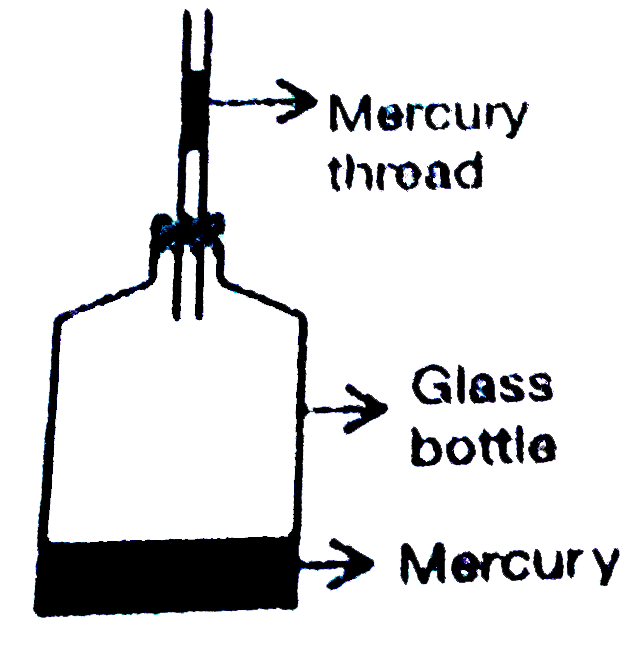A porcelain crucible is filled with 1kg of mercury at room temperature (20∘C). The crucible is then placed inside a furnance, kept there for sufficient time and finally removed. It is found that it contains only 0.8Kg of mercury. Calculate the temperature of the furnace. (Average cubical expansivity of mercury =18.2×10−5K−1 and that of porcelain=2×10−5K−1)
The correct Answer is:1523∘C
Topper's Solved these Questions
Similar Questions
A weight thermometer contains 500g of mercury at 0∘C. If the temperatue is raised to 100∘C how much mercury will be expelled. (Cubical expansivity of mercur =182×10−6.∘C−1 and that of glass =27×10−6.∘C−1)
View SolutionA glass flask with volume 200 cm3 is filled to the brim with mercury at 20∘C. How much mercury overflows when the temperature of the system is raised to 100∘C? The coefficient of linear expansion of the glass is 0.40×10−5K−1. Cubical expansion of mercury =18×10−5K−1.
View Solution
Knowledge Check
Consider two thermometers T1 and T2 of equal length which can be used to measure temperature over the range θ1 to θ2. T1 contains mercury as the thermometric liquid while T2 contains bromine. The volumes of the two liquids are the same at the temperature θ1. The volumetric coefficients of expansion of mercury and bromine are 18×10−5K−1 and 108×10−5K−1, respectively . The increase in length of each liquid is the same for the same increase in temperature. If the diameters of the capillary tubes of the two thermometers are d1 and d2 respectively, then the ratio d1:d2 would be closest to
A6.0B2.5C0.6D0.4
A glass flask with volume 200 cm3 is filled to the brim with mercury at 20∘C. How much mercury overflows when the temperature of the system is raised to 100∘C? The coefficient of linear expansion of the glass is 0.40×10−5K−1. Cubical expansion of mercury =18×10−5K−1.
View SolutionThe scale of a barometer is made of brass and is correct is 15∘C. The reading of the barometer is 0.754m at 5∘C. Correct this reading to 0∘C. (Linear expansivity of brass =18x10−6K−1 and cubical expansivity of mercury =18×10−5K−1)
View SolutionThe volume of a glass vessel is 1000 cc at 20∘C. What volume of mercury should be poured into it at this temperature so that the volume of the remaining space does not change with temperature? Coefficients of cubical expansion of mercury and glass are 1.8×10−4C−1 and 9.0×10−6C−1. respectively.
View SolutionThe volume of a glass vessel is 1000 cc at 20∘C. What volume of mercury could be poured into it at this temperature so that the volume of the remaining space does not change with temperature? Coefficients of cubical expansion of mercury and glass are 1.8×10−4∘C−1 and 9×10−6∘C−1 respectively.
View SolutionA glass tube is attached to the bottom of a thin iron rod of length 1m. To what height must the glass tube be filled with mercury so that the centre of mass of the pendulum formed will not rise or all with changes in temperature?
(Linear expansivity of glass =9×10−6K−1, that of iron =12x10−6K−1 and cubical edxpansivity of mercury =18.2×10−5K−1)
View SolutionA barometer having a brass scale reads 77.24 cm at a temperature of 20∘C. The scale is graduated to be accurate at 0∘C. What would be the readint at 0∘C ? Coefficient of cubical expansion of mercury =18×10−5.∘C−1 and linear expansion of brass −19×10−6.∘C−1
View SolutionA constant volume air thermometer is as shown in the figure below. Explain why the bottle is partly filled with mercury. Find the ratio fo volume of mercury present in the bottle to the volume of the bottle if the volume coefficients of mercury and glass are 1.8×10−4K−1and6×10−5K−1, respectively.

View Solution
